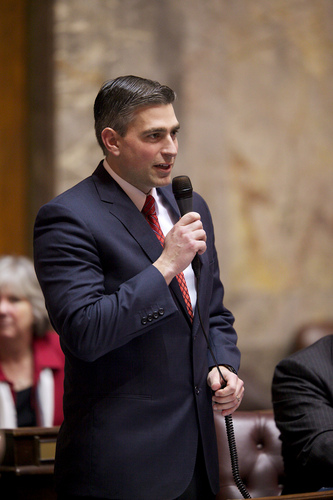Requiring a supermajority vote on all tax hikes, an idea once thought dead, could see new life this Legislative session. And Sen. Michael Baumgartner (R-Spokane) and Doug Ericksen (R – Bellingham) want to be the men to revive it – at least in the senate.
As Baumgartner is quick to point out, voters have overwhelmingly passed a two-thirds super-majority requirement on tax hikes in the legislature through the initiative process five times. They did so in 2010, when the Tim Eyman-powered Initiative 1053 received nearly 65 percent support at the ballot box, and reaffirmed the decision in 2012 with Initiative 1185, which was just as popular.
But it wasn’t to be. In February 2013 the state Supreme Court struck down the two-thirds super-majority law by a vote of 6-3, finding it unconstitutional. In the court’s majority decision, Justice Susan Owens wrote that the requirement, “would fundamentally alter our system of government,” and that “Washington’s government was founded as a representative democracy based on simple majority rule.” In the aftermath, it seemed the only way a two-thirds super-majority requirement would be possible was through a change of the state constitution – a move that, ironically, would require a two-thirds super-majority vote itself (as well as a vote of the people).
But Baumgartner says he has a better idea – one he unapologetically admits is little more than an “end around,” of the state Supreme Court’s 2013 decision. It’s a plan that has the potential to turn the first day of the Washington state legislative session into a high-drama affair. And perhaps that’s the point.
One Monday, when the state legislature gathers in Olympia for the start of what’s sure to be a grueling, budget-focused 120-day session, the Senate will be tasked with approving procedural rules that will govern how the body operates. It’s standard (read: boring) stuff, and it typically goes down without a hitch. Really, it’s a parliamentary artifact that goes back to the days of powdered wigs.
This year, however, if Baumgartner and Ericksen have their way the Majority Coalition Caucus – which enjoys a 26 to 23 majority in the 49 member senate – will look to insert a rule that would require a two-thirds majority vote to move all tax increase bills from second to third reading. An idea described in detail back in December by Jason Mercier, the Director of the Center for Government Reform at Washington Policy Center, the tactic is a creative way to (possibly) get around that pesky 2013 Supreme Court decision. And given the conservative majority in the Senate, it’s a possibility that can’t be taken lightly. If enacted, such a rule would have serious implications in all budget-related negotiations moving forward, likely dooming revenue generators like Inslee’s proposed capital gains tax before they have a chance to get off the ground, and putting into question where the court-ordered McCleary money to better fund public education will come from.
In a joint press release, Baumgartner and Ericksen describe their brazen plan: “Right now it takes a simple majority vote to pass most bills in the state Senate, 25 of 49 members. Under the proposed rule changes, it would take a two-thirds vote of the state Senate to pass any measure that raises taxes – 33 of 49 members. A key legal point is that the rule would not apply to final passage, but rather to the procedural motion that is required to advance such bills for a final vote on the Senate floor. The state constitution authorizes each chamber of the Legislature to adopt its own procedural rules. … The essential difference between the Senate rule-change proposal and the law that was passed repeatedly by voters is that it would apply to just one chamber of the Legislature. Yet it would have much the same effect, because all bills must be approved by both chambers. That means every measure that raises taxes would still have to clear the two-thirds hurdle. A two-thirds vote also would be required on motions to concur with House bills that raise taxes, before final passage.”
In Baumgartner’s interpretation, the Senate gets to set its own rules, and by requiring a two-thirds super-majority vote (in the Senate only) to advance a tax-hike bill from second to third reading, they don’t run afoul with the Supreme Court’s previous decision.
But will it work? And is it legal?
“I feel very comfortable with the rule. At the end of the day, we’re there to serve the people. I think it’s a good way to start session,” Baumgartner tells Seattle Weekly, calling the Supreme Court’s 2013 decision “erroneous.”
“It focuses the discussion from the start of session on living within the state’s means, and helps that process along,” the Republican from Spokane continues. “Obviously, you want to be cautious if you change the rules. That’s why it has to be a rule change that stands up to public scrutiny. … It seems very very straightforward to me, and it’s immensely popular with the public. It’s something that would effectively reinstate a measure that voters have approved five times.”
Others, of course, aren’t so sure. Sen. David Frockt (D – Seattle), who was a plaintiff in the legal challenge to I-1053, tells Seattle Weekly that–despite the differences–he believes what Baumgartner is attempting to do is just as unconstitutional as the supermajority initiatives.
“I’m very familiar with the constitutional issues, and from a legal standpoint there’s no way that a senate rule can trump a constitutional rule of law,” says Frockt. “That is the reason that the Eyman statute was unconstitutional. A statue can’t trump a constitutional amendment. They can try to dress it up, but that’s form over substance.”
In fact, whether or not Baumgartner and Ericksen’s plan is legal is a subject of considerable debate. Obviously, they believe it is. So do people like Mercier and Tim Eyman. Frockt, on the other hand, is adamant that it’s not, while some of his Democratic colleagues are less sure–though they’re equally perturbed by the specter. More confounding, even if the rule is unconstitutional, we probably won’t know that for certain unless it is included in the Senate’s procedural rules, gets used to block a tax hike, and then gets challenged in court – a potentially lengthy process.
“I think it’s probably an open question at this point,” says Sen. Jamie Pedersen (D – Seattle) when asked about the proposed rule’s legality. “I think it’s interesting that there’s not a good precedent for taking a particular class of bills [in this case, tax-hike bills] and requiring a larger majority. To say that a class of bills … would require a higher vote is a novel question. … It would be a substantial obstacle to our work this session.”
Pedersen goes on to say that, given the 2013 Supreme Court ruling, he believes such a rule would be found “out of order” by Lt. Governor Brad Owens, who serves as president of the Senate, but also admits that he “would never rule anything out.” The senate, he points out, is a “very unpredictable place.”
Indeed it is. While the Majority Coalition Caucus enjoys a 26-23 majority in the senate, and could – in theory, at least – enact a two-thirds super-majority rule simply along party lines, whether they have the votes to do so remains a question mark. As Jordan Schrader of The News Tribune in Tacoma has reported, Sen. Bruce Dammeier (R-25) opposes changing senate rules. And Senate Majority Leader Mark Schoesler (R-Ritzville) was noncommittal Thursday during the annual AP forum, saying only that the matter would be taken up in caucus. With unanimous resistance from the Democrats a given, it would only take two rogue Republicans to scuttle Baumgartner’s power play. That’s not much wiggle room.
Still, Baumgartner says he’s “optimistic.”
“I would hope so,” Baumgartner says when asked whether he thinks his plan will work. “Almost every member of our caucus ran on two-thirds taxpayer protection. … We’ll find out. It takes 25 votes to change the rule.”
“The rule of thumb is you can do about anything [in the senate] with 25 votes.”
On Monday, we may find out just how true that statement is.








